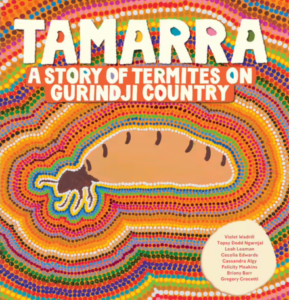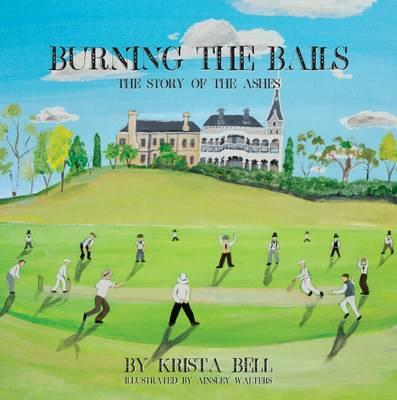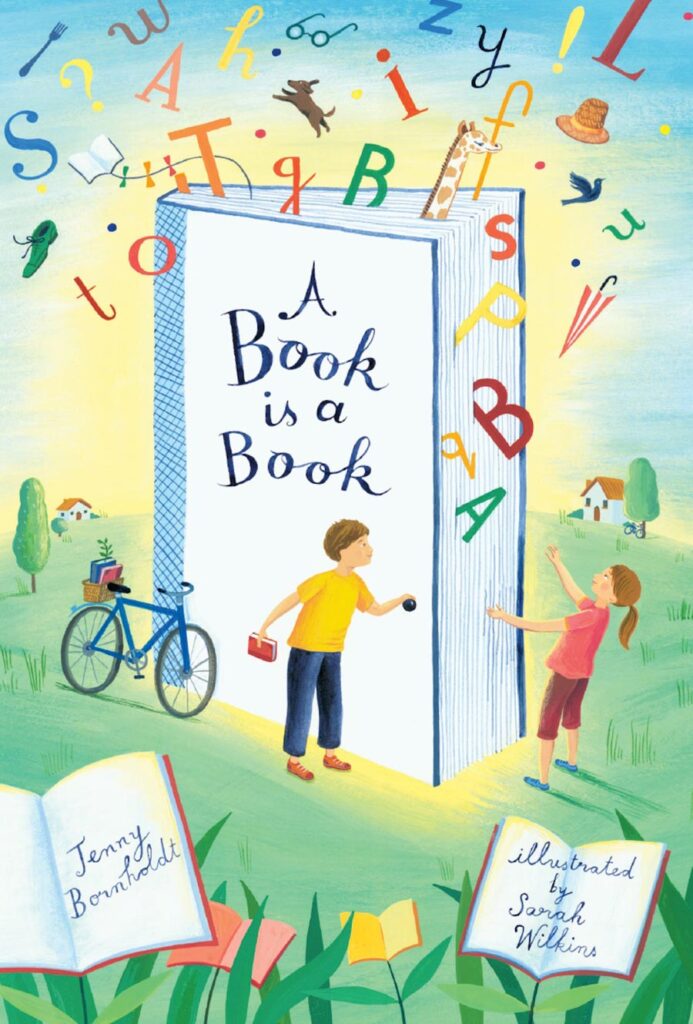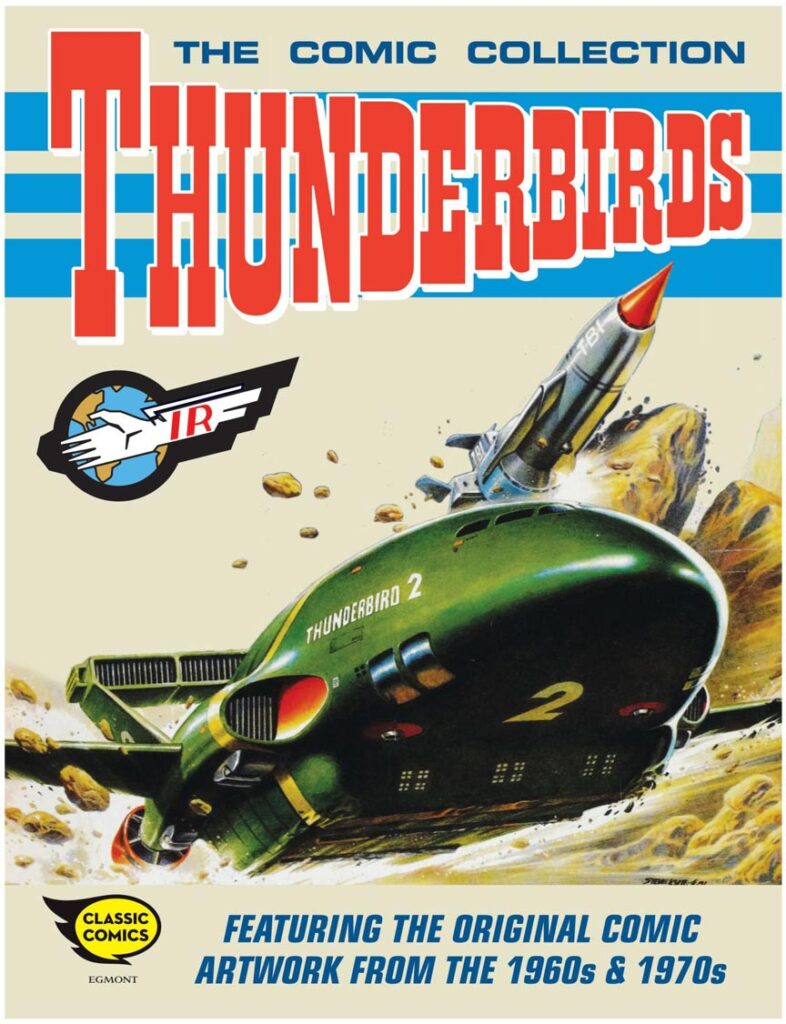Violet Wadrill, Topsy Dodd Ngarnjal, Leah Leaman, Cecelia Edwards, Cassandra Algy, Felicity Meakins, Briony Barr, Gregory Crocetti (text), and Karungkarni Art and Culture (illustrator) along with artists below, Tamarra: A Story of Termites on Gurindji Country, Hardie Grant Explore, July 2023, 80 pp., RRP $29.99 (hbk), ISBN 9781741178302
| ARTWORK AND PHOTOGRAPHY | ||
| Topsy Dodd Ngarnjal | Mary Smiler | Sophia Donnelly-Patterson |
| Violet Wadrill | Rosie Smiler | Tara Long |
| Rosemary Johnson | Joanne Stevens | Merrilyn Frith |
| Serena Donald | Rachel Rennie | Narelle Morris |
| Leah Leaman | Lucy Tanami | Theresa Yibwoin |
| Pauline Ryan | Cassandra Algy | Brenda L Croft |
| Margaret Winbye | Caroline Jimmy | Briony Barr |
| Magdalene Winbye | Martina Mandijerry | Penny Smith |
| Roberta Winbye | Cecelia Edwards | Kalkaringi School Students |
Tamarra: A Story of Termites on Gurindji Country is a notable book, now shortlisted for Book of the Year Award in 2024. Congratulations to its team and I wish you Book of the Year Award!
This title might feel long, but necessary to captivate young readers. There is also much appeal in the cover artwork and young people might potentially glimpse an ant on the cover before reading termites in the title to their surprise! I call this shortlisted book Tamarra as a shorter title version and I correctly pronounce the word as Da-Marr-a which translates to termite mound in Gurindji Country. While acknowledging and paying respect to the traditional custodians of the land, this book, literature, and history is one that I highly recommend for the Gurindji Country.
Named the coordinator and an award winning Professor of Linguistics, Felicity Meakins returns with Tamarra, her latest project following an ongoing list of remarkable projects she has led in Gurindji community including Kawarla: How to Make a Coolamon (Batchelor Press, 2014), Yijarni: true stories from Gurindji country (Aboriginal Studies Press, 2016), Birrka Marnini: Making Things Mudburra (Batchelor Press, 2019), and Karu: Growing up Gurindji (Spinifex Press, 2019). Professor Meakin’s additionally produces videos at ICTV.com.au with this meticulous research to keep the stories of Gurindji Country, their people and their languages defined and documented for the future generations to learn.
There are intriguing cultural practices and cultural theories that we continue to learn from the everlasting spiritual bonds and guardianship of the land that the Gurindji community have inspired us with since their historical walk off in 1966. There are captivating, cultural experiences shared from this First Nations community revealing their family bonds, gifts of nature and their land connections that we must continue to embrace for tomorrow. The Gurindji people of the Northern Territory speak to us in volumes about rights, voices, identity, family, and earnt respect which they hold strong and value.
The text languages are attractively distinguished and colour coded through this trilingual book. Readers have a QR code found inside the book that is linked to an audio version reading of the book in Gurindji and Gurindji Kriol languages. Readers are directed to a website dedicated to the Tamarra project. Teacher notes are found on this website and teachers will find more web links that share Gurindji Country knowledge. Readers will find a glossary inside Tamarra supporting the understanding of translations and pronunciations. There are immersive features for readers to learn words in English, Gurindji and Gurindji Kriol.
From delving myself into a world of insects, I have explored historical human-termite relationships along a journey in Gurindji Country. Termites might not be everyone’s favourite insect buddies, nor mine, however there was a great journey discovering their fascinating and complex social structures in this vast 80-page picture book. Readers will be sparked with a captivating world of termites to unravel the secrets behind their often underestimated abilities with author and microbiologist Dr Gregory Crocetti from the Scale Free Network, and the Small Friends Book Series. Without spoiling too much, readers become engrossed with a mix of extremely disgusting microbe surprises.
With my termite fascination and my travel credit, I am now prepared to uncover more hidden wonders of nature on a journey to the extraordinary Council House 2 building in Melbourne. The entire building is in the design of a termite mound and produces natural heating or cooling with zero emissions!
Recommended readers for this attractive picture book are Year 2-7 and age 7-12. It’s a particularly inspiring book for the children of Gurindji Country because the book adopts a pedagogy similar to the 8 Aboriginal Ways of Learning (2009). This pedagogy is defined by a narrative-driven learning experience with elements of non-fiction narrative, use of language symbols, photographs and artwork images. Aboriginal learners build on an understanding of local land, living and place from their Elders and their educators through resourcing this valuable learning book.
Coming to the end of my review, I share these two creative and educational experiences for Gurindji Country students to delve into with meaningful art, design and pedagogy from the story of Tamarra.
- Shared Painting Story Stones: Encourage learners to create their own story stones inspired by this book. Provide smooth stones or cardboard discs and art supplies like acrylic paints or coloured markers. Invite learners to paint or draw images relating to one of the book themes, for example termites, Gurindji language or bush medicine. Once completed, share these story stones with each other and discuss the symbolism, language and meaning behind the designs.
- Building Termite Mounds in Groups: Invite learners to construct termite mounds using materials like clay, paper mache, egg cartons, paper cups and bowls. First research the structure and design of termite mounds together and then apply this knowledge to building new versions with the materials provided. During the activity encourage learners to explore teamwork, perseverance and design required in creating complex structures. I recommend using this video. By stacking the cups, learners will explore the stability and balance required to create a sturdy base, just as termites do when building their mounds. This activity not only reinforces the concept of teamwork and perseverance but also allows learners to visually see the process of termite mound construction.
Enjoy the process of creating and learning together, much like this book has been from the outstanding creators!
Reviewed by Chantelle Ciccotosto






